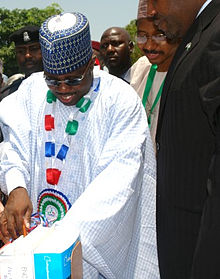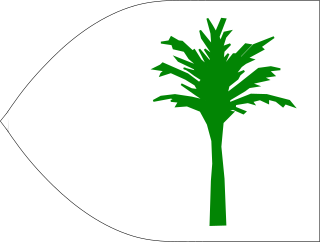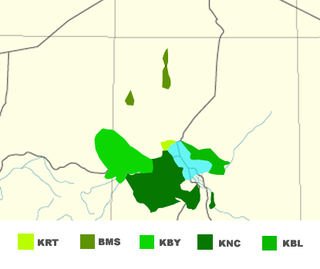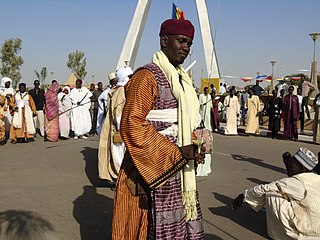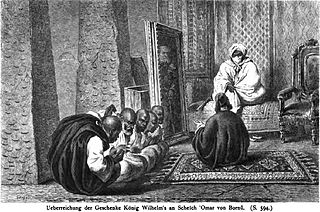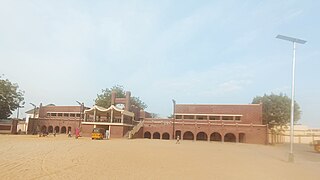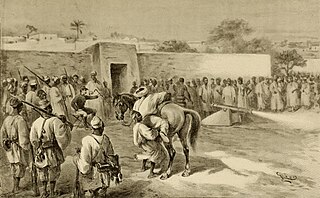Background
Kanuri peoples include several subgroups, and identify by different names in some regions. The Kanuri language was the major language of the Bornu Empire and remains a major language in southeastern Niger, northeastern Nigeria [8] [9] and northern Cameroon, but in Chad it is limited to a handful of speakers in urban centers. [10]
The largest population of Kanuri reside in the northeast corner of Nigeria, [11] where the ceremonial Emirate of Bornu traces direct descent from the Kanem-Bornu empire, founded sometime before 1000 CE. Some 3 million Kanuri speakers live in Nigeria, not including some 200,000 speakers of the Manga dialect. [12] The Nga people in Bauchi State trace their origins to a Kanuri diaspora. [13]
In southeastern Niger, where they form the majority of the sedentary population, the Kanuri are commonly called Barebari (a Hausa name). [7] The 400,000 Kanuri population in Niger includes the Manga subgroup, numbering some 100,000 (1997) in the area east of Zinder, who regard themselves as distinct from the Barebari. [7]
Around 40,000 (1998) members of the Tumari subgroup, sometimes called Kanembu, are a distinct Kanuri subgroup living in the N'guigmi area, and are distinct from the Chadian Kanembu people. [14] In the Kaour escarpment oasis of eastern Niger, the Kanuri are further divided into the Bilma subgroup, numbering some 20,000 (2003), and are the dominant ethnic group in the salt evaporation and trade industry of Bilma. [15]
Kanuri speak varieties of Kanuri, one of the Nilo-Saharan languages. Divisions include the Manga, Tumari, and Bilma dialects of Kanuri and the more distinct Kanembu language. [16]
Inheriting the religious and cultural traditions of the Kanem-Bornu state, The Kanuri people are predominantly Sunni Muslim.
In Chad, Kanembu speakers differentiate themselves from the large Kanuri ethnicity. The Kanembu are centered in Lac Prefecture and southern Kanem Prefecture. Although Kanuri was the major language of the Bornu Empire, in Chad, Kanuri speakers are limited to handfuls of speakers in urban centers. Kanuri remains a major language in southeastern Niger, northeastern Nigeria and northern Cameroon. [17]
In the early 1980s, the Kanembu constituted the greatest part of the population of Lac Prefecture, but some Kanembu also lived in the Chari-Baguirmi Prefecture. Once the core ethnic group of the Kanem-Borno Empire, whose territories at one time included northeastern Nigeria and southern Libya, the Kanembu retain ties beyond the borders of Chad. For example, close family and commercial ties bind them with the Kanuri of northeastern Nigeria. Within Chad, many Kanembu of Lac and Kanem prefectures identify with the Alifa of Mao, the governor of the region in precolonial times. [10]
Originally a pastoral people, the Kanuri were one of many Nilo-Saharan groups indigenous to the Central South Sahara, beginning their expansion in the area of Lake Chad in the late 7th century, and absorbing indigenous Nilo-Saharan, Niger-Congo and Chadic (Afro-Asiatic) speakers. According to Kanuri tradition, Sef, son of Dhu Ifazan of Yemen, arrived in Kanem in the ninth century and united the population into the Sayfawa dynasty. This tradition however, is likely a product of later Islamic influence, reflecting the association with their Arabian origins in the Islamic era. Evidence of indigenous state formation in the Lake Chad area dates back to circa 800 BCE at Zilum. [18]
Extent of the five main
Kanuri language groups today.
The farthest extent of the medieval Kanem-Bornu state.
Ceremonial
bodyguard of the Sheikh of Bornou in his full regalia, after a drawing by a British visitor in the 1820s. The mounted knight was central to the Bornu state, and many Kanuri people still value horsemanship and horses.
Photograph of Kanuri women dancing (1910s)
Photograph of Kanuri women dancing (1910s)
Traditional state
Following the downfall of the Bornu Empire and the Scramble for Africa in the 19th century, the Kanuri were divided under the rule of the British, French and German Empires.
Despite the loss of the Kanuri-led state, the Shehu of Bornu continues as the head of the Bornu Emirate. This traditional Kanuri/Kanembu state maintains a ceremonial rule of the Kanuri people based in Maiduguri, Borno State, Nigeria but acknowledged by the 4 million Kanuri in neighboring countries. The Shehu ("Sheikh") of Bornu draws his authority from a state founded before 1000 CE, the Kanem-Bornu Empire. [24]
The current ruling line, the al-Kanemi dynasty, dates to the accession of Muhammad al-Amin al-Kanemi in the early 19th century, displacing the Sayfawa dynasty which had ruled from around 1300 CE. The 19th Shehu, Mustafa Ibn Umar El-Kanemi, died in February 2009, [25] and was succeeded by Abubakar Ibn Umar Garbai El-Kanemi. [26]

